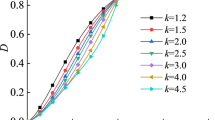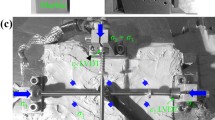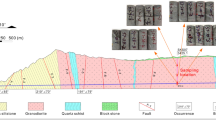Abstract
The high magnitude of in situ geostress under deep underground conditions and the intermediate principal stress under complex stress conditions have a significant influence on the static or dynamic mechanical behavior and strength characteristics of intact rock material. The constitutive relationship for quasi-brittle materials (e.g., intact rock or concrete) subjected to large strains, high strain rates, high pressures, and complex stress states was investigated, but the mechanical behavior and strength characteristics for rock under high pressures and complex stress states have not yet been elucidated. This study mainly focuses on constitutive modeling and theoretical prediction of the dynamic mechanical behavior and strength characteristics for rock under high dynamic pressures and complex stress states. A damaged elastoplastic constitutive model for intact rock is established in this study by taking the influence of a high strain rate, high pressure, and complex stress state into account. The failure mechanism of deeply buried rock engineering under high in situ stress and an additional impact pressure from a high-velocity underground impact was analyzed in this paper. The influence of the high pressure and intermediate principal stress on the quasi-static or dynamic mechanical behavior and strength characteristics of the deeply buried rock was investigated under a complex stress state.











Similar content being viewed by others
References
Barton NR, Lien R, Lunde J (1974) Engineering classification of rock masses for the design of tunnel support. Rock Mechanics and Rock Engineering 6(4):189–239
Cai M (2008) Influence of intermediate principal stress on rock fracturing and strength near excavation boundaries—Insight from numerical modeling. International Journal of Rock Mechanics & Mining Sciences 45:763–772
Cai M, Kaiser PK, Uno H, Tasaka Y, Minami M (2004) Estimation of rock mass strength and deformation modulus of jointed hard rock masses using the GSI system. International Journal of Rock Mechanics and Mining Sciences 41(1):3–19
Chen L, Wang CP, Liu JF, Liu J, Wang J, Jia Y, Shao JF (2015) Damage and plastic deformation modeling of Beishan Granite under compressive stress conditions. Rock Mechanics and Rock Engineering 48(4):1623–1633
Hanchak SJ, Forrestal MJ, Young ER (1992) Perforation of concrete slabs with 48 MPa (7 ksi)and 140 MPa (20 ksi) unconfined compressive strengths. International Journal of Impact Engineering 12(1):I-7
Hoek E, Brown ET (1980) Empirical strength criterion for rock masses. Journal of Geotechnical and Geoenvironmental Engineering ASCE 106:1013–1035
Hoek E, Brown ET (1997) Practical estimates of rock mass strength. International Journal of Rock Mechanics and Mining Sciences 34(8):1165–1186
Johnson GR (2011) Numerical algorithms and material models for high-velocity impact computations. International Journal of Impact Engineering 38(6):456–472
Johnson GR, Holmquist TJ (1992) A computational constitutive model for brittle materials subjected to large strains, high strain rates, and high pressures. In: Meyers, Murr and Staudhammer, editors. Proceedings of EXPLOMET Conference. San Diego: Marcel Dekker Inc., New York
Johnson GR, Holmquist TJ (1994) An improved computational constitutive model for brittle materials. In: Schmidt SC, Shaner JW, Samara GA, Ross M (eds) High-Pressure Science and Technology. AIP Press, United States of America
Kachanov LM (1958) Time of the rupture process under creep condition. Tvz Akad, Nauk. SSR. Otd. Tech. Nauk. 8(1):26–31
Lee J, Fenves GL (1998) Plastic-Damage Model for Cyclic Loading of Concrete Structures. Journal of Engineering Mechanics ASCE 124(8):892–900
Lemaitre J (1971) Evaluation of dissipation and damage in metals submitted to dynamic loading. Proceedings of ICM-1, Kyoto.
Li YL, Ma ZY (2017) A damaged constitutive model for rock under dynamic and high stress state. Shock and Vibration 2017(15715):1–6
Li JC, Ma GW, Yu MH (2008) Penetration analysis for geo-material based on unified strength criterion. International Journal of Impact Engineering 35(10):1154–1163
Liu HY, Lv SR, Zhang LM et al (2015) A dynamic damage constitutive model for a rock mass with persistent joints. Int J Rock Mech Min Sci 75:132–139
Liu J, Liang X, Xue Y et al (2020) Numerical evaluation on multiphase flow and heat transfer during thermal stimulation enhanced shale gas recovery. Appl Therm Eng 178:115554
Ma ZY, Dang FN, Liao HJ (2014) Numerical study of the dynamic compaction of gravel soil ground using the discrete element method. Granular Matter 16(6):881–889
Marinos V, Marinos P, Hoek E (2005) The geological strength index: applications and limitations. Bulletin of Engineering Geology and Environment 64:55–65
Michelis P (1985) Polyaxial yielding of granular rock. Journal of Engineering Mechanics ASCE 111(8):1049–1066
Mogi K (1971) Fracture and flow of rocks under high triaxial compression. Journal of Geophysical Research 76:1255–1269
Mogi K (1972) Fracture and flow of rocks. Tectonophysics 13(11):541–568
Papanikolaou VK, Kappos AJ (2007) Confinement-sensitive plasticity constitutive model for concrete in triaxial compression. International Journal of Solids and Structures 44(2):7021–7048
Scholtes L, Donze FV (2013) A DEM model for soft and hard rocks: role of grain interlocking on strength. Journal of the Mechanics and Physics of Solids 61(2):352–369
Simulia DS (2014) Abaqus 6.14 Help Documentation. USA: Dassault Systems simulia Corp.
Singh M, Raj A, Singh B (2011) Modified Mohr-Coulomb criterion for non-linear triaxial and polyaxial strength of intact rocks. International Journal of Rock Mechanics & Mining Sciences 48(4):546–555
Wang YX, Cao P, Huang YH et al (2012) Nonlinear damage and failure behavior of brittle rock subjected to impact loading. Int J Nonlinear Sci Numer Simul 13(1):61–68
Xie LX, Lu WB, Zhang QB, Jiang QH, Wang GH, Zhao J (2016) Damage evolution mechanisms of rock in deep tunnels induced by cut blasting. Tunnelling and Underground Space Technology 58:257–227
Xue Y, Teng T, Dang FN, Ma ZY et al (2020) Productivity analysis of fractured wells in reservoir of hydrogen and carbon based on dual-porosity medium model. Int J Hydrog Energy 45(39):20240–20249
Yu MH (2004) Advances in strength theories for materials under complex stress state in the 20th century. Advances in Mechanics 34(4):529–560
Yu MH, Zan YW, Zhao J, Yoshimine M (2002) A unified strength criterion for rock material. International Journal of Rock Mechanics & Mining Sciences 39(8):975–989
Zhang QB, Zhao J (2014) A review of dynamic experimental techniques and mechanical behaviour of rock materials. Rock Mechanics and Rock Engineering 47(4):1411–1478
Funding
The research described in this paper was funded by the National Natural Science Foundation of China (No. 51979225, 51722907) and the Fundamental Research Funds for the Central Universities Project (No. 300102268202).
Author information
Authors and Affiliations
Corresponding author
Additional information
This article is part of the Topical Collection on Geological Modeling and Geospatial Data Analysis
Rights and permissions
About this article
Cite this article
Ma, Z., Dang, F., Li, Y. et al. Influence of geostress field on dynamic mechanical behavior of intact rock. Arab J Geosci 14, 78 (2021). https://doi.org/10.1007/s12517-020-06313-7
Received:
Accepted:
Published:
DOI: https://doi.org/10.1007/s12517-020-06313-7




